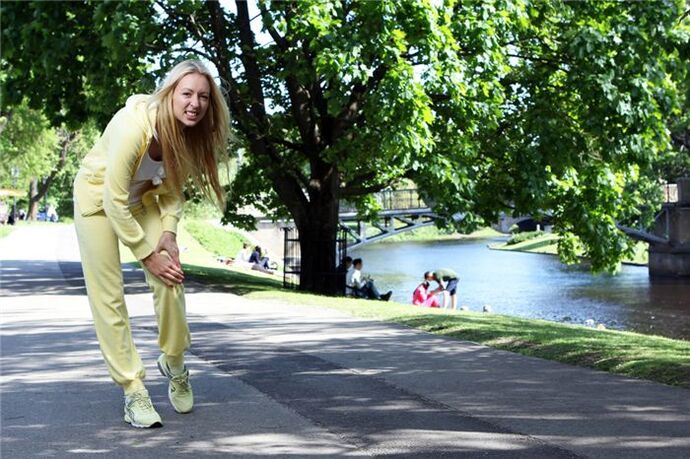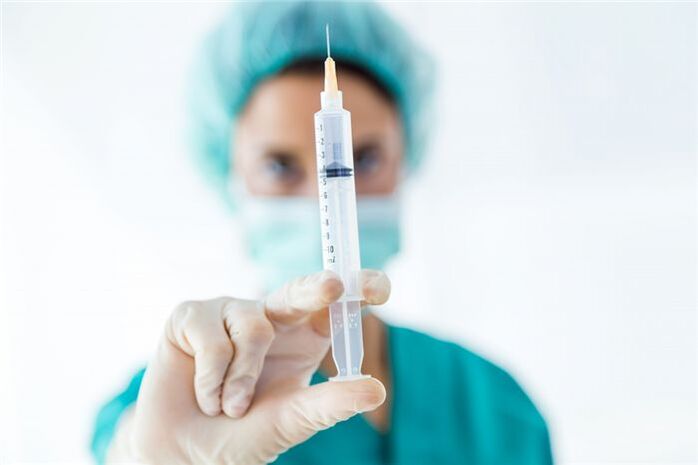Knee arthritisis a degenerative-dystrophic disease of cartilage tissue, leading to exposure of bone ends and impaired joint mobility. The disease is non-inflammatory in nature and progresses slowly - the transition from the initial stage to the disabling stage takes years to decades. Osteoarthritis of the knee is one of the top 5 causes of disability and disability worldwide.
Osteoarthritis of the knee (gonarthrosis) affects more than 20% of people over the age of 55, but the disease is rapidly aging - its symptoms appear more and more often by the age of 25.

Timely treatment of knee osteoarthritis will help avoid complications and destroy cartilage tissue.
Signs of knee osteoarthritis
The wear and tear of articular cartilage is accompanied by characteristic signs, the intensity of which depends on the stage of the disease.Usually, patients complain of:
- morning stiffness and reduced joint mobility (warm-up is required upon waking);
- pain and discomfort in the knee, which increases with exertion (long walking, running, or standing) and subsides with rest;
- at the 2nd stage - the so-called. the onset of pain appears after a long time in one position;
- increased fatigue, often attributed to age-related changes;
- a dry, often repeated cry when bending and breaking the knee;
- edema and other inflammatory symptoms appear in the 2nd stage of the disease due to trauma to the peristaltic tissues;
- hypersensitivity, increased symptoms in the cold season.
When attempting to bend the gonarthrosis-affected knee to a stop, there will be sharp pain and a feeling of physical impediment. In the later stages, even after knee osteoarthritis has been treated, the patient has a disturbed gait (becomes waddling, the patient stiffens on foot), deforms the limbs in the form of an "O" or"X. "
The insidiousness of the disease lies in the fact that it can progress to a latent form for many years, and the first significant symptoms usually appear only in stage 2 - when there is no longer the possibility of full recovery of the working cartilage. Translate.
Therefore, it is important to seek medical attention at the first sign of knee discomfort - such as weakness, as if the pain persists until there is insufficient synovial fluid production. Remember: knee pain is not normal, regardless of age. Timely examination and treatment of grade 1 knee osteoarthritis can completely protect you from painful joint pain in old age.
What happens if knee osteoarthritis is left untreated?
If self-medication, failure to follow the doctor's recommendations or no treatment, knee osteoarthritis progresses on average 3-8 times faster than with complex therapy. If gonarthrosis is advanced, the patient may lose the ability to move normally even before reaching retirement age.
Especially important is the effective treatment of knee osteoarthritis in the acute stage. It can be triggered by cold, wet weather, physical or emotional stress, allergies, intoxication, moving to a different climate – in other words, any shake-up to the body. with the body. Exacerbation of arthropathy occurs with the destruction of a large number of chondrocytes. In response, the body produces enzymes designed to process and remove dead cells. However, if their concentration is too high, healthy areas of cartilage are also affected - the cell membranes become thinner, foci of erosion appear on the synovial membrane of the joints. This process, if not stopped with drug treatment of osteoarthritis, can go on for several weeks, and with chronic stress, lack of sleep or poor diet, it can go on forever. .
Ultimately, if left untreated, osteoarthritis of the knee leads to a complete reduction of the vascular space of the joint space due to the growth of osteoblasts. The space required for normal movement closes and the patient cannot bend the leg even 30-45°. The difficulty is not only climbing the stairs but also trying to get up from the sofa or move normally. This condition is accompanied by pain, from which conventional painkillers do not help. In such cases, the only option is to treat osteoarthritis of the knee - surgery, complete replacement of the joint structure with a prosthesis, and long-term rehabilitation afterward. But even in this case, most patients cannot return to a completely normal life.
Treatment of knee osteoarthritis
Depending on the stage of the disease and the condition of the joint, conservative or surgical treatment of knee osteoarthritis is applied.
The treatment of knee osteoarthritis grade 1 is always done according to the conservative method - combining the circumstances and the patient's good self-discipline, the disease can be cured or stabilized.
Treatment of grade 2 knee effusion is based on the principle of applying all conservative treatment methods, however, the doctor may decide to intervene with minor surgery in the joint if the disease is severe or has complications.
Treatment of grade 3 knee osteoarthritis almost always requires surgery.
Comprehensive conservative treatment of arthritis of the knee joint involves eliminating pain and inflammation, restoring cartilage tissue, and increasing the joint's range of motion. For this, the patient is prescribed an orthopedic regimen of load and rest, drugs of systemic and local action (hormonal and non-hormonal anti-inflammatory drugs, analgesics, chondroprotectors). and others). Innovative biological methods are also gaining popularity - injecting knee osteoarthritis drugs directly into the joint pocket. In this case, injections of PRP (platelet-rich plasma) are used, as well as injections of stem cells taken from the patient's own adipose tissue. In parallel, adjuvant and rehabilitation methods are connected - physiotherapy, massage, manual therapy, therapeutic exercises.
Surgical treatment of knee osteoarthritis is performed in cases where medications are impotent.With this pathology, the doctor may prescribe the following interventions:
- Knee arthroscopy. The collective name for a group of minimally invasive procedures that remove part of damaged joint tissue or bone, or remove part of the articular membrane. It allows you to delay or eliminate prostheses, as well as eliminate discomfort in the early stages of the disease. Mainly used for the treatment of knee arthropathy in patients under 60 years of age.
- Cut bones. A surgery to cut off part of the bone and correct the load shaft on the affected knee, allowing you to slow degenerative changes. It is usually done in the treatment of grade 2 knee effusion.
- Endogenous drugs. Partial or complete replacement of the knee joint with a titanium implant, which lasts 15-20 years. This technique is a last resort as it carries certain risks. Recommended for patients over 55 years of age.
All these operations require a recovery period and have a number of contraindications, so the best option is prevention (exercise therapy, chondroprotectors) and treatment of knee arthropathy in its early stages.
In addition to the main methods of treatment, dietary therapy and methods of reducing body weight are applied. To unload the diseased joint, bandages and other orthopedic devices (canes, orthopedic insoles, etc. ) are used.
Treatment of knee effusion prescribed by a rheumatologist or orthopedist. At the first appointment, he palpates the joint, does movement tests, then instructs the patient to have a CT scan or X-ray.
Therapeutic exercises for knee joint disease
Exercise therapy lower extremities is considered the most effective method of pain relief and treatment of knee osteoarthritis of the 1st degree today. The first results from therapeutic exercises come after 2-4 weeks of continuous training. Continuity in the treatment of knee osteoarthritis is one of the main factors affecting the effectiveness of exercise therapy. A formal study session is held once a day every day, it is also recommended to do at least 3-4 training sessions a day.

Therapeutic exercises for knee effusion during remission will help reduce pain.
The main task of physical exercises in the treatment of knee osteoarthritis is to strengthen the thigh and lower leg muscles, maintain the elasticity of ligaments and tendons, and prevent muscle atrophy that is characteristic of joint disease. This allows you to transfer the load from the joint to the structures around the joint - and thus slows down the mechanical wear of the cartilage, reducing inflammation.
Knee osteoarthritis treatment exercise is done for both legs! If there is a sharp pain, stop or continue the session at a more gentle pace.
- Starting position - lying on your back. One leg extended on the floor, the other raised to a 90° bend (leg parallel to the floor). We perform the movements with the shin up and down, within the range of motion of the joint allowed.
- Starting position - lying on your back. Do a cycling exercise.
- Starting position - prone. We swing our legs in turn, trying to bring the heels as close to the buttocks as possible.
- Starting position - lying on your side, arms bent under the head or extended overhead in line with the body. The other hand is on the side. We swing up with a straight leg. We switch sides.
- Starting position - lying on your back. We pull the legs along the floor forward with the heels (away from you), the socks will "look at yourself".
- Starting position - prone. We do the "boat" exercise. If physical strength does not allow, we place the palms on the sides of the chest and in turn draw the legs back, feeling the stretch on the back of the thighs and shins.
- Starting position - lying on your back. We alternately rotate the feet, trying to depict the full circle with socks.
- Starting position - standing against a wall. We squat slowly and gently, without lifting our backs off the wall to distribute the load. When the leg is bent at the knee at a 90° angle, we begin the upward motion.
- Starting position - standing. Alternately we swing our legs forward, backward and sideways.
Please note: therapeutic exercises after joint surgery have their own specific characteristics and vary depending on how many days have passed since surgery. It is prescribed by a doctor - a surgeon or a rehabilitation specialist.
Knee osteoarthritis massage
Therapeutic massage for knee arthritis is performed on both legs. At first, at least 10-12 sessions are usually required with a massage-rehabilitation specialist or with the assistance of hydromassage equipment, however, restorative massage can be performedsimple at home. It includes the following types of movements:
- superficial caressing and rubbing (up and down, clockwise and counterclockwise);
- probing and stretching with the fingertips of deeper tissues;
- pinch and tap on the skin.

Massage therapy for osteoarthritis of the knee should be performed by a specialist, not harmful to the diseased joint
Self-massage can be combined with drug treatment of osteoarthritis: applying ointments or balms before or during training sessions is not necessary. You can also take a warm shower before the procedure.
Important: massage is contraindicated in patients with inflammatory symptoms (osteoarthritis or exacerbation of joint disease). In this case, acute phase therapy is required.
Diet therapy for arthritis
The standard nutritional regimen for the treatment of knee osteoarthritis requires:
- limiting foods and dishes rich in simple carbohydrates (white bread, confectionery, snacks, sweets, potatoes, sugar);
- exclude processed (instant) and high-salt foods - fast food, semi-finished products, hot dogs;
- Avoid alcohol, decaffeinated coffee, and fatty meats.
Instead, put in the menu:
- dishes from sprouted and whole grains;
- fatty fish of the North Sea and diet poultry;
- cartilage (ears, nyushki, legs and other parts of farm animals rich in collagen), aspics and jelly;
- fruits and vegetables rich in vitamins and antioxidants (especially vitamins A, B12, C, E);
- nuts and other valuable sources of omega fatty acids and minerals.

Nutrition for Osteoarthritis of the Knee provides a balanced diet that helps restore cartilage.
It is also recommended to treat knee osteoarthritis with drugs - vitamin-mineral complexes (2 courses per year).
Physiotherapy for the treatment of knee osteoarthritis
The following physiotherapeutic procedures are used to effectively treat knee osteoarthritis and enhance the effects of medications:
- acupuncture therapy;
- laser therapy;
- UHF;
- therapeutic ultrasound;
- amplipulse;
- electrophoresis (including drugs - with analgin, novocaine or chymotrypsin);
- ozokerite and paraffin applications;
- thermotherapy (cryotherapy, thermoelectricity);
- electrophoresis (in particular, with hydrocortisone);
- conditioning therapy (sulfur bath, hydrogen sulfide).
Acupuncture in the treatment of grade 2 knee arthritis, as a rule, is not used.
Before visiting the procedure, it is necessary to consult a doctor - many types of physiotherapy are contraindicated in case of exacerbation of the disease.
Drugs to treat knee osteoarthritis
Drug treatment of knee osteoarthritis is carried out symptomatically and taking into account the individual patient's response to the selected drugs. Drug treatment — injections, ointments, or pills to treat arthritis of the knee — is usually prescribed as a course or as needed.

To choose the right drug for knee osteoarthritis, you should consult with your doctor, after researching, you will choose the necessary drugs.
There are several ways to treat knee osteoarthritis with drugs: to help patients live more easily, improve nutrition for cartilage, regenerate cartilage tissue, and maintain normal musculoskeletal system.
Non-steroidal anti-inflammatory drugs
To relieve exacerbations, NSAIDs in the form of tablets or capsules are taken in courses (about 12 days) or as needed, depending on the intensity of the pain syndrome. Uncontrolled intake of NSAIDs in violation of your doctor's instructions or recommendations will lead to stomach or intestinal ulcers. Extreme caution should be exercised when combined with glucocorticosteroids and drugs that affect blood clotting. Other risk factors are age over 65, smoking, and alcohol consumption during treatment. In these cases, doctors often recommend injections, bypassing the gastrointestinal tract. Along with NSAIDs, it is recommended to take gastroprotective drugs.
The maximum effect can be achieved when a combination of systemic NSAIDs (internal use) and external use - in the form of ointments, creams or gels. The second option provides a point effect on the affected joint and at the same time has a minimal effect on digestion.
Corticosteroids (steroids used to treat osteoarthritis of the knee)
Endocrine (HA) drugs are commonly used for the so-called. Knee-blocking steroids in cases where NSAIDs are not enough to relieve pain and inflammation.
Glucocorticoid injection is considered as a last resort in the treatment of knee osteoarthritis with drugs. They provide pain relief as early as 20 minutes after administration, but can lead to hormonal imbalances and cartilage damage if used incorrectly. Because of side effects, many orthopedic surgeons prefer knee surgery over long-term HA therapy.
Chondroprotectors in the treatment of arthritis of the knee joint
Chondroprotective agents based on extracts from the veins and cartilage of cattle, marine fish and shellfish contribute to the restoration of synovial cartilage, and are therefore indispensable for the effective treatment of knee osteoarthritis. Chondroprotectors contain a large number of glycosaminoglycans - natural polymers from which cartilage tissue is built. Thus, they make chondrocytes (chondrocytes) more stable, promote their growth, enrich synovial fluid.
Unlike anti-inflammatory drugs, chondroprotectors have practically no contraindications. They provide a cumulative, long-lasting effect - the first improvements occur after 1-3 months of admission, and the duration of the course is 3-6 months.
Skin Irritants
External preparations for the treatment of arthritis of the knee with a local stimulant effect improve blood circulation and nutrition of the joints, and also distract the patient from the pain. For this purpose, ointments, gels, creams and balms are used based on natural ingredients - bee venom, hot pepper extract.
In the presence of an allergic reaction (persistent redness and pain on the skin, rash), during pregnancy and lactation, as well as in the presence of other contraindications, it is better to avoid warm ointments fortreat knee arthritis and limit bathing with warm water, applying and anti-inflammatory outside.
Translate pseudo-match
If there is too little synovial fluid in the joint, the sliding of the joint surfaces will be disturbed. And most importantly, cartilage starvation begins, because the synovial fluid that nourishes it like a sponge normally provides nutrients for cartilage tissue growth and maintenance. To prevent cell destruction and mechanical wear of knee cartilage, doctors may prescribe injections of high molecular hyaluron derivatives. Injections in the treatment of knee osteoarthritis (joint supplements) are made directly into the joint capsule, providing quick pain relief, lasting from 3 to 12 months after the end of the course. However, with the advent of prostheses, the risk of necrotic or infectious changes in the joint remains.
Antispasmodics, analgesics, muscle relaxants
In case of muscle spasms and tension that prevent the patient from sleeping, creating pain when moving, doctors prescribe antispasmodic and muscle relaxants.
Simple analgesics are not used in the treatment of arthritis of the knee joint, because they mask the pain, but do not reduce the inflammation. You can take them or NSAIDs without a prescription for up to 10 days, after which you need to see a doctor.
Released drug form for the treatment of dry joints of the knee joint
For the convenience of patients, drugs for treating knee osteoarthritis are produced in many different forms. Is there a difference between them and which one should I choose?

Preparations for the treatment of knee arthritis have several forms of release: packs, injections, ointments, tablets. Choose what suits you best.
Capsules, sachets and tablets for the treatment of arthritis of the knee
Nonsteroidal anti-inflammatory drugs, corticosteroids, chondroprotectors, and muscle relaxants are available in oral form. In this case, they are easy to dose, can take without the involvement of medical staff, very easy to control which part of the course has been completed. When taken orally, chondroprotectors and NSAIDs are quite bioavailable (especially in sachet form).
Solution for injectables
In the form of injections, you can take NSAIDs, HA, chondroprotectors and muscle relaxants mentioned, as well as synovial fluid prostheses. This drug treatment of osteoarthritis of the knee exhibits maximum bioavailability.
This method of treating knee effusion with this medicine is very safe for digestion, but it needs to be injected by qualified medical personnel (intravenous, intra-articular or intra-articular). Intramuscular injections of the buttocks or thighs can be performed independently.
Products for external use
Local anti-irritant, anti-inflammatory and chondroprotective ointment is used externally for the treatment of dryness of the knee joint. The advantage of using this drug is the direct effect on the affected tissues. But the skin barrier impedes the active ingredients - alas, usually only 5% of the active ingredients reach the desired tissue layers.



























